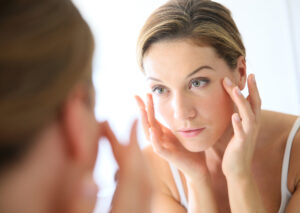Eyelid Surgery
The eyes are among the most telling indications of one’s emotions and age, giving them an enormous impact on a person’s overall appearance. Unfortunately, the skin surrounding the contours of the eyes is much more thin and delicate than the rest of the face. The eyes also have less internal support than other facial structures and produce fewer oil glands. These anatomical differences are exacerbated by genetics, sun damage, exhaustion, exercise, and stress, often making the eyes one of the first features to reveal signs of facial aging. All of these factors contribute to why a range of people—younger and older patients alike—can benefit from eyelid surgery (blepharoplasty).
“I needed a lift ‘to put things back where they belong’. My droopy eyes and saggy lower face, to be specific. The outcome is just what I wanted and comments from friends who did not know, like: “you look rested” or ”your new diet sure makes you look fresh” only confirmed that this was totally worth it. I’m super happy that I recognize myself in the mirror, a younger self. I don’t look ‘tucked’ or different.
Explore Topics On This Page
Key Blepharoplasty Terms to Know
As with any procedure, patient education prior to your appointment will deepen your understanding of blepharoplasty and help you determine whether surgery is the best treatment to address your concerns. Rest assured that Dr. Miller and our skilled team will walk you through the entire surgical process, but some of the most common key terms related to eyelid surgery generally include:
- “Hooding”: Known to develop with age, “hooding” describes a condition in which excess eyelid skin accumulates on the upper lash line. This excess tissue may sag below the lash line and potentially interfere with your field of vision.
- Laxity: Refers to loose, inelastic tissue. Laxity may lead to a crepey or hanging look in the skin, and often develops as natural collagen production decreases.
- Ptosis: A medical condition in which the eyelids droop to a position lower than normal. Eyelid ptosis is typically caused by a weakening of the levator muscles (which support the upper eyelids), and blepharoplasty is not to be confused with ptosis repair — which addresses the internal musculature of the upper eyelid.
- Transconjunctival: A technique used to cosmetically improve the lower eyelids using an internal incision.
What are the Benefits of Eyelid Surgery?
Blepharoplasty will enhance the contour of the eyelids, providing beautiful rejuvenation of the area around the eyes. Blepharoplasty is often used to:
- Remove excess skin around the upper and/or lower eyelids
- Tighten skin and resolve skin laxity
- Remove or reposition fat and/or muscle to create a smoother contour above or below the eyes
- Smooth wrinkling around the eyes
- Improve the appearance of dark circles or puffiness
- Restore the scope of vision
Yielding results that look elegant and natural, Dr. Miller takes great care to place incisions discreetly within the lower lash line or along the natural crease of the eyelid.
Candidates for Eyelid Surgery
Ideal candidates for eyelid surgery typically exhibit:
- Excess skin around the upper and/or lower eyelids
- Upper eyelid hooding
- Fatty deposits in the upper eyelids
- Under-eye bags, or fat deposits affecting the lower eyelid regions
- Dark circles below the eyes
- Lines or wrinkles on the eyelids
These characteristics can make a person seem older than they actually are, or constantly look tired and stressed. If you wish to invigorate your appearance, eyelid surgery can serve as a solution to rejuvenate and refresh the eyes. A consultation with Dr. Miller will help you learn whether eyelid surgery is an ideal treatment for your cosmetic goals.
How is the Eyelid Surgery Procedure Performed?
Eyelid surgery can either be performed on the upper eyelids, the lower eyelids, or both, depending on your particular needs and aesthetic goals. During the consultation process, Dr. Miller will recommend a treatment plan that can best address your concerns. Eyelid surgery typically takes one to two hours to complete; however, this will depend on the individual treatment plan. In some cases, Dr. Miller may recommend combining eyelid surgery with an additional procedure to achieve the patient’s overall goals. For example, a brow lift (forehead lift) can be performed to treat forehead wrinkles and sagging eyebrows.
Non-surgical cosmetic enhancement procedures like our facial filler treatments can also be excellent complements to eyelid surgery.
Upper Eyelid Surgery
Upper eyelid blepharoplasty is designed to eliminate excess skin over the eyes and correct the “hooding” effect that can result from sagging tissue. During surgery, an incision is made along the crease of the upper eyelid to conceal any scarring. Excess skin is removed and some pockets of fat may be reshaped or removed.
Lower Eyelid Surgery
For the lower eyelids, surgery is designed to tighten sagging skin and muscle, reduce excess fat bulging beneath the eyelids, and diminish the appearance of puffiness and dark circles. During surgery, an incision is usually made along the rim of the lower eyelashes, which conceals the incision line after the healing process is complete. Excess skin is excised, musculature may be tightened and pockets of fat may be reshaped or redistributed to fill hollows.
The Eyelid Surgery Consultation Process
During your consultation, Dr. Scott Miller will perform a physical examination of your eyelids and facial structure to determine if you are a good candidate for eyelid surgery. Dr. Miller will also review your medical history and discuss any pre-existing ophthalmologic conditions you may have (including glaucoma or dry eye). If you are a good candidate for eyelid surgery, Dr. Miller will thoroughly discuss your expectations and then design a customized treatment plan around your unique needs and reasons for surgery.
What is Recovery From Eyelid Surgery Like?
During the recovery period, most patients are up and around within a day or two; however, screen time is strictly limited for 4 days after surgery. Most people are able and ready to return to work after 7 to 10 days. Those who have laborious or physically demanding jobs may need to wait longer before it’s safe to return to work again. Sutures are usually removed after one week. Following surgery, soreness can be controlled by medication and cold compresses, which can also limit swelling and bruising. Occasionally, patients may experience excessive tearing or light sensitivity. This usually responds to eye drops and should not last long. Patients are provided a detailed post operative plan.
What Results Can I Expect From Blepharoplasty?
Eyelid surgery provides a refreshed and more energetic appearance. For those whose sagging eyelids were limiting their vision, eyelid surgery can also provide a widened view of the world. Patients are always pleased to see how eyelid surgery can lead to such a dramatic improvement in their appearance. While the aging process will continue, results achieved from blepharoplasty are long-lasting.
Will Eyelid Surgery Affect My Vision?
Eyelid surgery has been known to improve vision issues related to excess skin obscuring a patient’s eyesight, which is one of the primary reasons why men and women consider the procedure. If eyelid skin is blocking part of your vision, blepharoplasty can help.
Temporary vision changes immediately after eyelid surgery are also normal and shouldn’t be a cause for alarm. Feelings of dryness, itchiness, tightness, or soreness in the eyes may occur and should subside naturally as your eyes heal. Blurry vision for a few days after the procedure is also common. Be sure to follow Dr. Miller’s aftercare instructions regarding medications and eye drops to help facilitate the healing process. We understand that the initial recovery period after blepharoplasty can be disconcerting, but it is very important to avoid using your eyes for TV, email, or scrolling on a mobile device. You must also keep the area clean and avoid rubbing your eyes until your incisions fully heal.
Are There Alternatives to Eyelid Surgery?
Blepharoplasty is one of the most compelling treatment options to refresh the upper face, but it’s not the only procedure that can reduce signs of aging. Other facial plastic surgery services can help attain a brighter, more energetic appearance as well, such as a brow lift — a procedure designed to diminish frown lines, treat sagging brows, and soften deep creases in the upper face. With brow lift surgery, men and women who struggle with unintentionally conveying a stressed or displeased expression can reclaim a more youthful and carefree look. The procedure is among the most popular male facial plastic surgery options at our practice, although a brow lift also achieves beautiful results for women.
For lower facial enhancement, options like a facelift, neck lift, and lip lift can also help balance and redefine contours of the face and neck. Jowls and sagging skin preventing a smooth, youthful look can be addressed with a facelift and neck lift, while lip lift surgery provides greater facial harmony for patients who want to reduce an aged, elongated upper lip. After reviewing your concerns, our team would be happy to discuss the many treatment options that can help you achieve your goals.
Is Non-Surgical Blepharoplasty Possible?
There is currently no non-surgical treatment that can achieve the same quality of results as blepharoplasty. However, if you would like to refresh the upper third of the face and achieve a more youthful look around the eyes, you may benefit from treatment with BOTOX® Cosmetic. This minimally invasive injectable can be an excellent way to smooth forehead creases, frown lines between the eyebrows, and crow’s feet that line the corners of the eyes. While BOTOX® Cosmetic is not designed to treat lax eyelid skin, it can be used to help smooth expression lines and reduce some signs of facial aging without the need for downtime. Dr. Miller can listen to your aesthetic goals in a consultation and suggest the most appropriate treatment options to address your concerns.
What are the Risks of Blepharoplasty?
Like all surgical procedures, blepharoplasty comes with a chance of potential complications during or after the procedure. The risk of serious side effects is very low for patients who are good surgical candidates, who closely follow post-operative instructions, and who are under the care of a qualified, reputable plastic surgeon. Nevertheless, the American Society of Plastic Surgeons (ASPS) outlines the following as risks of blepharoplasty:
- Infection or bleeding
- Complications with anesthesia
- Dryness or sensitivity to light
- Eyelid irregularities
The safety of our patients is paramount at Miller Cosmetic Surgery, and Dr. Miller will discuss all of the risks, benefits, and limitations associated with eyelid surgery so you gain a full understanding of the procedure. Ensuring your blepharoplasty provider has the training and experience of a board-certified, fellowship-trained plastic surgeon is the most effective way to minimize surgical risks. We take great pride in providing our patients with optimal outcomes and the highest standard of care possible.
Additional Blepharoplasty FAQs
What is transconjunctival blepharoplasty?
The transconjunctival procedure refers to an eyelid surgery technique that uses a small internal incision to smooth eye bags and puffiness in the lower eyelid. Under-eye bags can develop for genetic or age-related reasons as the fat pockets around the eyelid begin to bulge forward. Transconjunctival blepharoplasty can reposition this fat to reduce an aged or fatigued look, thereby providing you with a more energetic aesthetic. Since the incision is made on the inside of the eyelid, the procedure should not leave external scars.
How long after eyelid surgery should I wait before I wear makeup?
You should wait to apply makeup for at least two weeks after surgery, or until your incisions are fully healed. Putting on makeup before it is safe to do so can expose your incisions to dirt, bacteria, and other impurities that increase the risk of infection. Dr. Miller will let you know when you can resume makeup application based on the progress of your healing. Once you can safely use makeup again, we recommend replacing your old products with new cosmetics to lower the chance of bacteria buildup.
How can I reduce swelling after blepharoplasty?
Swelling after surgery can be reduced by limiting activity, using bandages or compresses as directed, and not smoking. Over-the-counter pain medication can also temporarily alleviate discomfort from post-surgical swelling and/or bruising. While the majority of swelling should resolve within the first two weeks, mild inflammation may linger for as long as a couple of months.
When can I wear contacts after eyelid surgery?
If you wear contacts, Dr. Miller will instruct you to switch to eyeglasses for at least two weeks after surgery. This is required to limit tension on your incisions and prevent twisting and tugging of the skin.
What’s the difference between eyelid surgery and ptosis repair?
Eyelid surgery is largely considered a cosmetic procedure while ptosis repair is performed to correct a medical condition. Patients experience ptosis when their levator muscles (the muscles that support the upper eyelids) stretch or separate and are no longer able to fully uphold the eyelids. As a result, the upper lid can sag and cover the eye, often conveying a tired expression on top of obstructing one’s line of sight. Ptosis repair is a medical procedure designed to tighten the levator muscles and treat this condition. Blepharoplasty, on the other hand, is performed to improve aesthetic concerns.
Will insurance cover eyelid surgery?
Though insurance doesn’t cover most cosmetic procedures, many patients look to our reputable financing options to help manage the costs of blepharoplasty. If you’re considering the procedure to correct hooding and restore the full range of your vision, however, eyelid surgery may be deemed a medical necessity by some insurance companies. We encourage you to reach out to your doctor and insurance provider to learn whether you may qualify for full or partial coverage. At Miller Cosmetic Surgery, we do not accept any insurance payments. Qualified patients can coordinate for direct reimbursement from their insurance company.
How long do the results from blepharoplasty last?
Eyelid surgery results typically last at least 10 to 15 years or longer depending on your genetics and lifestyle factors such as how well you take care of your skin, whether you smoke, and how often you use sun protection. The skin will continue to lose elasticity over time, so preventative skincare is essential. High-quality skincare products and non-surgical skin rejuvenation treatments can often help you maintain the outcome of your blepharoplasty. While nothing will stop the natural aging process, eyelid surgery can be an excellent procedure to help you age more gracefully.
Can eyelid surgery repair a lazy eye?
Unfortunately, “lazy eye” is an ophthalmological condition that is not caused by loose, excess skin; therefore, the vision issues that result in a lazy eye cannot be corrected with eyelid surgery. Since blepharoplasty is only meant to improve cosmetic concerns, such as puffiness and dark circles, the procedure would not help individuals with a lazy eye.
Does eyelid surgery for men differ from blepharoplasty for women?
While surgical techniques are generally the same for both male and female patients, Dr. Miller always considers the anatomical differences and desires of each person when performing any procedure. Distinctions in skin thickness, facial contours, and ideals of beauty exist between men and women, and Dr. Miller will take these factors into account during your blepharoplasty. This personalized approach allows him to achieve results that look natural and harmonious with the unique character of your face.
What is functional blepharoplasty?
“Functional blepharoplasty” simply refers to an eyelid surgery procedure that removes excess skin in order to improve visual function. “Hooding” and puffiness of the upper eyelids can sometimes obstruct the eyes, causing patients to lose the full range of their sight. Blepharoplasty can help restore the entire scope of vision by removing/repositioning excess tissue.









